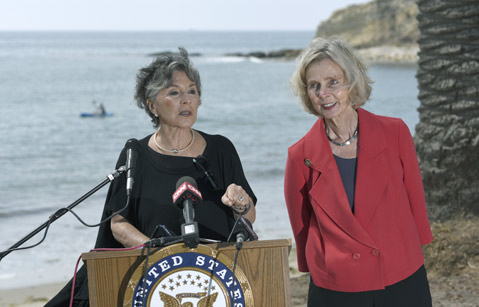Boxer and Capps Tour Refugio Oil Spill Site
State Senator and Congressmember Urge Tighter Oil and Pipeline Safety Regulations

Touring cleanup efforts this Tuesday at Refugio State Beach — where on May 19 an estimated 143,000 gallons of oil spilled from a corroded pipe operated by Plains All American Pipeline — U.S. Senator Barbara Boxer and Congressmember Lois Capps spoke in favor of holding Plains and the federal Pipeline and Hazardous Materials Safety Administration (PHMSA) to higher safety standards in order to protect the California coastline.
Capps first spoke of the “terrible toll” the Refugio Oil Spill has taken on the Santa Barbara community, acknowledging that lax federal safety standards played a large role in the incident. She expressed that she continues to work “vigilantly” to pressure both Plains and PHMSA into adopting new regulations to prevent history from repeating itself.
Both Boxer and Capps pointed to many unanswered questions for PHMSA and Plains, such as why a corroded pipeline was still in operation and why Plains waited nearly an hour and a half after the incident — over three hours after employees first noticed pressure irregularities — to launch an emergency response.
Boxer referenced the letter she, Capps, Senator Dianne Feinstein, and Senator Edward Markey sent to Plains CEO Greg Armstrong in June, in which they cited 175 safety and maintenance violations in the past 9 years. “I just think we have to hold this company to the highest standards until we can trust them,” said Boxer. “This economic and ecological disaster was a wakeup call.”
Additionally, Boxer echoed President Barak Obama and Governor Jerry Brown when she pushed for more clean energy to create jobs and preserve the coastline. She discussed the negative economic consequences that future oil spills would have on tourism in the Santa Barbara region.
There is still no update on when PHMSA will release its report on the spill, but Captain Jennifer Williams of the U.S. Coast Guard said Plains has spent $136 million so far in cleanup efforts and that 92.7 percent of the affected 96 miles of coastline have met cleanup goals.



